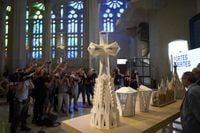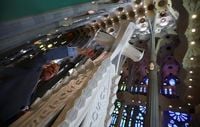Barcelona’s Sagrada Familia, the city’s iconic basilica and a masterpiece of Antoni Gaudí’s singular vision, is poised for an extraordinary milestone. After more than 140 years of construction, the church is ready to raise its central tower—an event that will not only redefine the city’s skyline but also crown the building as the tallest Christian church in Europe. As of September 18, 2025, the first pieces of the immense Tower of Jesus Christ are already in place, with the remaining sections set to be added in phases over the coming months, according to The Associated Press.
The basilica’s General Director, Xavier Martínez, shared the excitement with reporters, stating, “the tower will be finished at the end of this year or the beginning of 2026.” He reflected on the significance, telling The Associated Press, “This is an important moment in the history of the building of the Sagrada Familia because it will reach its maximum height. We are used to seeing skyscrapers like those in the United States (go up), but it is remarkable that in the 21st century we are building a cathedral.”
Once the central tower is complete, the Sagrada Familia will soar to 172 meters (564 feet), outstripping Germany’s Ulmer Münster church, which currently holds the record at 162 meters (531.5 feet). The new tower will be crowned by a massive cross and encircled by five other towers—one dedicated to Mary, and four, slightly shorter, for the four evangelists. The basilica’s distinctive silhouette, already a magnet for millions, will become even more striking against the Barcelona skyline.
But this moment is far from the end of the story. Esteve Camps, the church’s head of construction and project chairman, told Reuters that while the crowning of the central tower is imminent, work on the facades and interior will continue for several more years. “We cannot say whether it will be 10, 11 or 12 years … but we think that in normal circumstances, without obstacles, it is likely that in 10 years we could be finished,” Camps said. The COVID-19 pandemic, which caused a collapse in visitor revenues, delayed the project’s targeted completion beyond the original 2026 goal. Now, the team behind the basilica is cautiously optimistic, aiming for completion within a decade from 2025.
The timing of this achievement carries special resonance. Next year, 2026, will mark the 100th anniversary of Gaudí’s death. The basilica’s leaders are planning a series of events to celebrate his enduring legacy, which includes several other stunning buildings across Barcelona and Spain. The most anticipated of these is a solemn Mass to be held in Gaudí’s memory on June 10, the date he died after being struck by a streetcar in 1926. Pope Leo XIV has been invited to lead the commemoration and the opening ceremony of the new tower. According to Sagrada Familia officials, a response from the Vatican is expected later this month.
Gaudí’s vision for the Sagrada Familia was nothing short of audacious. A fervent Catholic, he infused the basilica with Christian symbolism and organic forms, creating a structure that is both deeply spiritual and architecturally unique. When the first stone was laid in 1882, few could have imagined the scale or the complexity of what was to come. Gaudí himself worked on the basilica from 1883 until his death, knowing full well that he would never see it finished. At the time of his passing, only one of its multiple towers had been completed.
The pace of construction has fluctuated over the decades, but recent years have seen a dramatic acceleration. As the basilica has become one of Europe’s biggest tourist draws, entrance fees have become the primary source of funding for ongoing work. In 2024, the Sagrada Familia welcomed a record 4.9 million visitors, with 15% of those coming from the United States. Despite its popularity, officials have made it clear that even after completion, the basilica’s maximum capacity will remain unchanged—an acknowledgment of both the building’s logistical limits and Barcelona’s broader challenges with tourism saturation.
Not all aspects of the basilica’s future are without controversy. Local authorities have yet to approve plans for a large staircase outside the Sagrada Familia’s main gate—a project that would require the demolition of at least one residential building and has sparked protests among neighbors. Camps expressed confidence that the staircase would eventually be approved, though he conceded that negotiations with the authorities could become contentious and might even end up in court if local opposition persists.
The basilica’s chief architect, Jordi Fauli, told Reuters that the central tower is already topping 155 meters, and the lower half of the massive cross that will crown it has been built. When finished, the Sagrada Familia will boast three facades and 18 towers, each intricately designed to reflect different aspects of Christian theology and Gaudí’s distinctive organic style.
The Sagrada Familia is no stranger to landmark moments. In 2010, Pope Benedict XVI consecrated the basilica and designated it a minor basilica—a recognition of both its spiritual and cultural significance. Yet, for many, the imminent completion of the central tower feels like the realization of a dream that has spanned generations. As Martínez put it, “it is remarkable that in the 21st century we are building a cathedral.”
Looking ahead, the challenges are as formidable as ever. The pandemic’s impact on construction timelines has been a sobering reminder of the unpredictability that can beset even the grandest of projects. And as Barcelona grapples with issues of tourism management and urban development, the Sagrada Familia remains at the heart of debates about the city’s future. The proposed staircase, in particular, has become a flashpoint, with residents voicing concerns about displacement and the preservation of neighborhood character.
Still, the sense of anticipation is palpable. With the central tower set to rise above the city, the Sagrada Familia is on the cusp of a new chapter—one that honors Gaudí’s vision while navigating the complexities of modern Barcelona. The basilica’s journey from a single stone in 1882 to the verge of becoming Europe’s tallest church is a testament to perseverance, faith, and the enduring power of architectural imagination.
As the world watches, Barcelona prepares to celebrate not just a building, but the culmination of a dream more than a century in the making.






